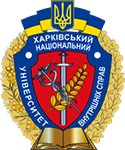Legal aspects of protecting the Ukrainian population against emergencies under martial law
Abstract
It is emphasized that the place of the hostilities consequences (the use of certain types of weapons against the civilian population) in the emergency system is a new problem for the world scientific thought. It is important to understand these consequences, in particular within the context of building a fair and proper legal status at the legislative level for those categories of workers involved in overcoming the consequences of such emergencies, not only employees of the SES and the police, but also of critical infrastructure, transport, healthcare, and trade.
The introduction of martial law on the territory of Ukraine affects the civil defence system in terms of the legal framework and the process of organising disaster protection, which is manifested in the following 1) in addition to the Civil Protection Code of Ukraine No. 5403-VI of 2 October 2012 and departmental by-laws in the field of civil protection of the population from emergencies, an extra legal basis appears in the form of the Decree of the President of Ukraine on the introduction of martial law, the provisions of which may define additional tasks in the field of civil defence; ensure the implementation of functions on protection of the population from emergencies; 2) the structure of public administration is changed, which provides for the establishment of military administrations, which, in cooperation with the military command, ensure coordination of public authorities, in particular those responsible for the protection of the population from emergencies; 3) during the legal regime of martial law, it is allowed to involve citizens of Ukraine in socially useful works carried out to eliminate man-made, natural and military emergencies that occurred during martial law and their consequences
It is noted that the procedure for engaging representatives of the categories specified in the Resolution of the Cabinet of Ministers of Ukraine “On Approval of the Procedure for Engaging Able-bodied Persons in Socially Useful Work under Martial Law” needs to be clarified at the level of individual by-laws and regulations at the level of peculiarities of their collection, notification, management of their activities, disciplinary liability and the system of payment of remuneration in cash or in kind, non-material incentives, their institutionalisation and methodological basis for organising and conducting such work.
Downloads
References
Kuznichenko, S. O. (2001). Management of internal affairs bodies in special conditions caused by anomalous man-made and natural phenomena (organizational and legal issues) [Candidate dissertation, Kharkiv National University of Internal Affairs].
Bratel, O. H. (2003). Civil and legal consequences of emergency situations [Candidate thesis, National Academy of Internal Affairs].
Zasunko, S. S. (2005). Administrative and legal regulation in the field of man-made safety in Ukraine [Candidate dissertation, National Academy of Internal Affairs of Ukraine].
Klochko, A. M., & Yemanov, V. V. (2010). Identification of threat levels that affect changes in the operational environment. Bulletin of Kharkiv National University of Internal Affairs, 2(49), 41–51.
Copyright (c) 2023 O. A. Lukianykhina, S. A. Petrovska

This work is licensed under a Creative Commons Attribution 4.0 International License.



